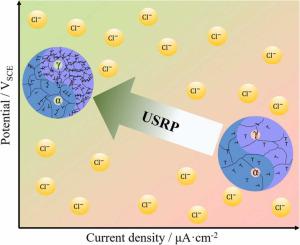Journal of Materials Processing Technology ( IF 6.7 ) Pub Date : 2022-08-05 , DOI: 10.1016/j.jmatprotec.2022.117750 Jiantao Zhang , Yuanzhi Zhu , Xiaoying Xi , Zhiyu Xiao

|
The UNS S32750 duplex stainless steel was treated by ultrasonic surface rolling process (USRP), and effects of the plastic deformation on microstructure evolution and corrosion behavior were investigated. Results demonstrated that grain refinement, a considerable increase of the fraction of low-angle grain boundaries (LAGBs, <10°), high density of dislocations and high surface compressive residual stress were produced by the USRP. In particular, the intensity of the evolution was inhomogeneous and it was higher for austenite than ferrite phase. What’s more, an evolution toward <001> of crystallographic orientation, a decrease in intensity of texture in α phase while increase in γ phase were found for the surface deformation layer. In addition, a small amount of deformation twins in γ phase were induced on account of the USRP treatment. Taking advantages of the microstructure evolution, the corrosion potential and critical pitting potential increased, while the passive current density and metastable pitting susceptibility decreased significantly for the USRP sample. The refined grains, high-density of dislocations and high surface compressive residual stress synergistically promoted the enrichment of Cr2O3 in the passive film on the deformation layer. The Cr/Fe ratio increased from 0.73 to 0.94 with the help of USRP, revealing a less defective and more stable passive film. Therefore, USRP is a promising and effective surface strengthening technique for DSS to improve the corrosion resistance in aggressive environments.
中文翻译:

UNS S32750双相不锈钢通过超声表面轧制工艺改变显微组织特征并提高耐腐蚀性能
UNS S32750双相不锈钢采用超声波表面轧制工艺(USRP)处理,研究了塑性变形对显微组织演变和腐蚀行为的影响。结果表明,USRP产生了晶粒细化、小角度晶界(LAGB,<10°)的比例显着增加、位错密度高和表面残余压缩应力高。特别是,演变的强度是不均匀的,奥氏体相的强度高于铁素体相。更重要的是,在表面变形层中发现了晶体取向向<001>的演变,α相的织构强度降低而γ相的增加。此外,由于USRP处理,在γ相中产生了少量的变形孪晶。利用微观结构演变,USRP 样品的腐蚀电位和临界点蚀电位增加,而钝化电流密度和亚稳态点蚀敏感性显着降低。细化晶粒、高密度位错和高表面压缩残余应力协同促进Cr富集2 O 3在变形层上的钝化膜。在 USRP 的帮助下,Cr/Fe 比从 0.73 增加到 0.94,显示出缺陷更少且更稳定的钝化膜。因此,USRP 是一种很有前途且有效的表面强化技术,用于 DSS 以提高在腐蚀性环境中的耐腐蚀性。











































 京公网安备 11010802027423号
京公网安备 11010802027423号